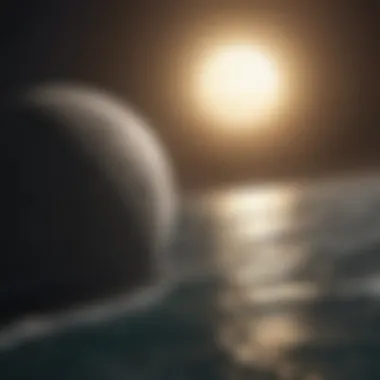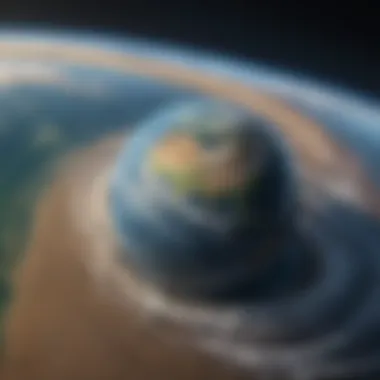Understanding the Causes of Ocean Tides: A Deep Dive


Intro
Ocean tides represent a captivating phenomenon that affects coastlines and marine environments. Their patterns are not random; they stem from a complex interplay of gravitational forces and natural elements. Understanding the underlying causes can enhance our appreciation of tidal behavior and its significance to ecological and human systems.
In this piece, we will dissect the mechanisms driving ocean tides, focusing on gravitational interactions primarily with the Moon and the Sun. Additionally, the rotation of the Earth will be analyzed, along with how geographical features influence local tidal behaviors. By exploring these components, we aim to illuminate the intricacies of tides and their relevance in today’s world.
The implications of tidal cycles extend beyond mere observation. Human activities, including urban development and climate change, may alter these natural patterns. Hence, a thorough discussion on these impacts is also warranted as we seek to comprehend the full spectrum of tides in relation to our planet's hydrosphere.
Foreword to Ocean Tides
Ocean tides are a fundamental aspect of our planet's hydrosphere, impacting various ecological and geological dynamics. As we explore this phenomenon, we identify the primary forces behind tides, including gravitational interactions mainly with the Moon and the Sun. Understanding tides is essential for several reasons, including their crucial roles in marine ecosystems, navigation, and climate regulation. Each tidal cycle contributes to nutrient distribution in coastal waters and influences the behavior of numerous marine species.
Presenting an in-depth analysis of ocean tides allows one to appreciate their complex nature. Thus, we will dissect not only the basic definitions but also the vital implications of tidal phenomena on Earth systems. Knowing how tides work can guide coastal management and promote sustainable practices.
Defining Ocean Tides
Ocean tides refer to the periodic rise and fall of sea levels caused by the gravitational pull exerted primarily by the Moon and the Sun on Earth's oceans. These movements create two tidal bulges on opposite sides of the Earth. The interaction is not a simple upward and downward movement; rather, it involves intricate balancing forces at play in the Earth's gravitational field.
In essence, the planet experiences a cycle of high and low tides, typically occurring twice every day in most locations. The regularity of these cycles is a result of the predictable positioning of the Moon and Sun relative to Earth. Understanding the specifics of these cycles requires examining how gravitational forces interact with the Earth's rotational dynamics.
Importance of Tides in Earth Systems
Tides play a significant role in shaping Earth's environment and ecosystems. Here are some of their key functions:
- Marine Ecosystems: Tides facilitate the movement of nutrients and organisms between the ocean and coastlines. This exchange is vital for the health of estuaries and coastal ecosystems.
- Navigation: Knowledge of tidal patterns is essential for maritime navigation, as it influences the timing and safety of boat passage.
- Coastal Regulation: Awareness of tidal dynamics is crucial for effective coastal management, as it helps predict flooding and erosion incidents.
- Climate Impact: Tides contribute to the overall distribution of ocean currents, which ultimately influence global climate patterns.
In summary, ocean tides are not merely a curiosity; they are a critical element of Earth's physical and biological systems. Recognizing their impact is paramount for researchers and practitioners working in environmental sciences, marine biology, and climate studies. Understanding tides equips us with insights that can shape effective strategies for managing the Earth’s resources.
Gravitational Forces and Their Role
Gravitational forces are central to understanding the dynamics of ocean tides. The interaction between gravitational attractions of celestial bodies and Earth plays a significant role in shaping tidal patterns. Tides are not just predictable rhythmic changes in water levels; they are the result of complex gravitational interactions that influence various ecological and human activities. In this section, we explore the fundamental principles of gravitational forces, starting with Newton's law, before delving into the roles played by the Moon and the Sun.
Newton's Law of Universal Gravitation
Newton's law of universal gravitation provides the foundation for understanding tides. It states that every particle in the universe attracts every other particle with a force that is proportional to the product of their masses and inversely proportional to the square of the distance between their centers. This principle can be articulated mathematically as:
Where:
- (F) is the gravitational force between the masses,
- (G) is the gravitational constant,
- (m_1) and (m_2) are the masses of the two objects,
- (r) is the distance between the centers of the two objects.
This equation reveals that the strength of the gravitational pull diminishes with distance. Since the Moon is considerably closer to Earth than the Sun, its effect on tides is more pronounced. However, the Sun still plays a significant role despite its greater mass due to the larger distance from Earth.


The Moon's Gravitational Influence
The Moon is the primary driver of tides on Earth. Its gravitational pull causes a noticeable displacement of water in the oceans. As the Moon orbits the Earth, it pulls the water towards it, leading to a rise in sea levels known as high tide. Conversely, on the side of Earth opposite the Moon, inertia causes water to bulge out as well, resulting in another high tide. This creates a two high tide and two low tide cycle approximately every 24 hours.
Additionally, the Moon's position relative to the Earth changes over time, influencing the magnitude of tides. For instance, when the Moon is full or new, the sun, moon, and Earth align, resulting in larger tidal ranges known as spring tides. The alignment maximizes both the solar and lunar gravitational pulls, leading to greater extremes in high and low tides. In contrast, during the first and third quarters of the moon, the gravitational forces partially cancel each other out, leading to neap tides, which are smaller in range and occur when the tides are at their lowest.
The Sun's Gravitational Influence
While the Moon is the dominant force affecting tides, the Sun's gravitational influence is also significant. The Sun's mass is about 333,000 times that of the Earth, and yet its greater distance reduces its effect on tides when compared to the Moon. Nevertheless, it plays a crucial role alongside the Moon during specific lunar phases. During spring tides, the alignment of the Earth, the Moon, and the Sun generates higher than normal tidal ranges. This synergistic effect showcases how the gravitational forces from both the Moon and the Sun work together to create rhythmical movements in ocean levels.
In summary, gravitational forces, particularly those exerted by the Moon and the Sun, are foundational to understanding ocean tides. Their interplay creates a complex system that is vital for ecological balance, navigation, and coastal community planning. Understanding these forces is crucial for scientists and researchers studying the Earth's hydrosphere and its interactions within broader environmental systems.
Understanding Tidal Cycles
Understanding tidal cycles is crucial for comprehending how ocean tides function within the Earth's system. These cycles are driven by gravitational forces and have a significant impact on various coastal and marine environments. The interplay between the Moon and Sun generates predictable patterns in tidal heights and frequencies, affecting marine biology, navigation, and climate.
Tidal cycles also inform how humans engage with bodies of water, particularly in coastal zones. Activities such as fishing, shipping, and recreation all rely on accurate predictions of tidal behavior. It is also essential for managing coastal ecosystems, which depend on tidal movements for nutrient distribution and habitat sustainability.
Additionally, factors such as the Earth's rotation and the specific geographic layout of coastlines must be evaluated to achieve deeper insights into tidal behavior. By analyzing these cycles, educators, scientists, and oceanographers obtain essential data that can aid future research in climate science and the effects of human activity on tidal patterns.
Continuous monitoring of tidal cycles offers insights into climate change impacts and assists in sustainable management of coastal environments.
Lunar Tides
Lunar tides refer to the tidal changes brought about primarily by the Moon's gravitational pull. The Moon exerts a relatively strong force on Earth due to its proximity. As Earth rotates, different locations experience varying tidal heights. This is why locations on the same coast can have different tidal timings.
The phase of the Moon affects the intensity and timing of these tides. During a new moon or a full moon, the gravitational pull from the Moon aligns with that of the Sun, resulting in higher high tides and lower low tides commonly referred to as spring tides. In contrast, when the Moon is in its first or third quarter phases, lower tidal ranges, known as neap tides, occur.
Solar Tides
Solar tides are influenced by the gravitational forces of the Sun. Although the Sun is much larger than the Moon, it is also much farther away, which results in a weaker effect on Earth's tides. Nevertheless, solar tides contribute to the overall tidal pattern and interact with lunar tides.
Solar tides follow similar cyclical patterns, as their effects are most notable during the new and full Moon phases when they align with the Moon. This interplay can amplify or reduce tidal effects depending on the phase of the lunar cycle. Understanding solar tides is essential for developing accurate tidal predictions, especially in areas heavily influenced by solar cycles.
The Spring and Neap Tides Phenomenon
The spring and neap tides phenomenon is essential for understanding how tidal variations occur. Spring tides happen during full moons and new moons, characterized by the highest and lowest tidal extremes. In contrast, neap tides occur during the first and third quarter phases of the Moon, resulting in smaller tidal changes.
The difference in tidal height between spring and neap tides is crucial for various marine and ecological activities. For instance:
- Certain fish species spawn during spring tides, taking advantage of the swift water currents.
- Coastal construction often considers tidal ranges for overall stability and environmental impact assessments.
In summation, being aware of these cycles enables better understanding and management of coastal ecosystems and human activities along the shore.


Corriolis Effect and Earth's Rotation
The Coriolis effect and the rotation of the Earth are two fundamental concepts that significantly shape ocean tides. Their interplay influences not only the dynamics of tidal movements but also the broader implications for marine ecosystems and coastal activities. Understanding these principles is crucial for comprehending how tides function on our planet and respond to various forces.
Understanding the Coriolis Effect
The Coriolis effect arises from the rotation of the Earth. As the Earth spins, different latitudes move at different velocities due to the spherical shape of the planet. This variance causes moving objects, such as air and water, to rotate or deviate from their intended path. In the context of ocean tides, the Coriolis effect causes the water to shift at an angle to the direction of the wind and the gravitational pull of the Moon and Sun.
Some key points about the Coriolis effect include:
- Direction of Movement: In the Northern Hemisphere, water deflects to the right, while in the Southern Hemisphere, it moves to the left. This can create circular currents in the ocean that have significant implications for tidal patterns.
- Impact on Tidal Currents: The deflection impacts the movement and distribution of tidal waves across different geographical areas. This can affect the timing and height of tides in specific locations.
- Weather Patterns: Beyond just tides, the Coriolis effect plays a vital role in the formation of weather systems, influencing storm paths and ocean currents.
Understanding this effect is critical when discussing how tides are not merely localized phenomena but are linked to larger oceanic patterns.
Impact of Earth's Rotation on Tides
Earth's rotation has a direct effect on tidal cycles. As the Earth spins on its axis, it influences the gravitational forces acting on ocean water. The rotation contributes to the periodic rise and fall of tides that we observe around coastlines.
Key considerations about the impact of Earth's rotation include:
- Tidal Timing: The rotation of the Earth affects the timing of high and low tides. Locations closer to the equator experience different tidal patterns compared to polar regions.
- Tidal Range Variations: The Earth's spin contributes to variations in tidal ranges. Certain areas may experience higher tides than others, a factor influenced by the combination of rotation and geographical features.
- Relation to the Coriolis Effect: Together with the Coriolis effect, Earth's rotation creates a more complex system of tidal evolution, influencing marine navigation and coastal management.
"The interplay of gravitational forces and the Coriolis effect shapes our oceans more than we might perceive at first glance."
As researchers and educators, we must consider these governing principles to better address the impacts of human activities on tidal systems and marine ecosystems.
Geographical Influences on Tidal Variations
Geographical features play a crucial role in the patterns and behaviors of ocean tides. Various elements, such as landforms, water bodies, and the layout of coastlines, significantly impact how tides manifest in different regions. By examining these influences, we gain insight into the complexity and variability found in tidal behavior. Understanding this topic is essential because it impacts coastal ecology, maritime navigation, and human activities.
The geographical nuances dictate not just the height of tides, but also their timing and frequency. For example, a coastal area with a wide continental shelf may experience a different tidal range than a location near deep ocean trenches. This variation is important not only for marine species that rely on tides for feeding and breeding, but also for human interventions, like the construction of ports and harbors.
Coastal Geography and Tidal Patterns
The shape and features of the coastline influence tidal range and flow. Areas with indented coastlines or large bays can experience amplified tides because of the funneling effect created by the land. Conversely, a straight coastline may lead to more uniform tidal patterns, with less variation in height. Additionally, coastal features such as cliffs, beaches, and tidal flats can alter the energy of incoming tides.
- Effects of Bay Shape: Tides can be higher in narrower bays than in wider ones due to the compression of water as it enters the inlet.
- Impact of Estuaries: These zones where freshwater meets saltwater often amplify tidal effects due to the mixing of waters, affecting both aquatic life and tidal dynamics.
Bays and Estuaries
Bays and estuaries serve as natural amplifiers of tidal action. They can significantly modify the tidal regime of the ocean, creating unique conditions that may not exist in open coastlines. Estuaries tend to have complex tidal patterns due to the interaction between river flow and ocean tides. Furthermore, the geology and sediment composition of these areas influence how tides are felt.
"Small changes in landform can lead to considerable differences in tidal characteristics."


The variable morphologies of bays and estuaries also determine habitat types. In these regions, tidal fluctuations create rich ecological environments by exposing and flooding different areas cyclically. This dynamic encourages biodiversity that relies on such natural rhythms.
Understanding the geographical influences on tidal variations is pivotal for managing coastal resources. It helps in predicting the potential impacts of rising sea levels and informs strategies for sustainable development along coastlines.
Human Impact on Tides
Human activities have become increasingly influential in shaping the patterns and behaviors of ocean tides. Understanding the intersections between human endeavors and tidal dynamics is essential, not only for scientists but also for policymakers, coastal communities, and environmentalists. This section will delve into the major factors of human impact, highlighting how construction, pollution, and climate change can affect tidal experiences across the globe.
Coastal Development and Engineering
In recent decades, coastal areas have experienced significant development. Urbanization, infrastructure projects, and other engineering works can alter natural tidal patterns. Structures such as seawalls, jetties, and ports often interfere with the natural flow of water. These developments can lead to changes in water levels and currents that influence the frequency and height of tides.
Some aspects to consider include:
- Alteration of natural habitats: Construction can destroy wetlands and mangroves that play a protective role against tidal forces.
- Increased erosion: Unnatural barriers can redirect wave energy, leading to more rapid erosion in some areas, which in turn influences tidal heights.
- Sediment displacement: Dredging for shipping lanes alters sediment distribution, affecting tidal amplitudes in surrounding areas.
- Water quality impacts: Increased runoff from urban areas can lead to pollution, adversely affecting the ecosystems associated with tidal patterns.
The cumulative effects of these alterations can disrupt local ecosystems and affect the livelihoods of communities relying on natural tidal cycles.
Climate Change and Tidal Extremes
Climate change is another significant factor impacting tides. Rising sea levels, alterations in climate patterns, and changing ocean temperatures directly affect tidal behavior. As global temperatures increase, glaciers and ice caps melt, contributing to rising sea levels. Consequently, higher sea levels can lead to more extreme high tides, also known as "king tides."
Several key impacts are worth noting:
- Increased frequency of flooding: Coastal areas may experience flooding during high tides, especially in places that were previously less affected.
- Loss of terrestrial habitats: Coastal ecosystems, like salt marshes and mangroves, may shrink due to inundation, impacting wildlife and plant communities.
"Coastal regions are among the most vulnerable to climate change, where rising sea levels may transform tidal landscapes forever."
- Alteration of tidal patterns: Climate change can also shift wind patterns, potentially changing the way water moves in and out of bays and estuaries.
The relationship between human activities and oceanic tides is complex and multifaceted. Recognizing these interactions can aid in addressing not only ecological concerns but also in formulating effective and sustainable policies for coastal management.
Culmination
The conclusion serves as a crucial junction in our exploration of ocean tides. It encapsulates the main ideas presented throughout the article and reinforces the significance of understanding this natural phenomenon. By summarizing the key points, we can elucidate the intricate mechanisms that govern tides. Gravitational forces exerted by the Moon and Sun, the interplay of Earth's rotation, and geographical elements all contribute to the ebb and flow of sea levels.
Summarizing Key Points
In this discussion, we covered several core aspects surrounding ocean tides:
- Gravitational Forces: The Moon's gravitational pull is the primary driver of tidal movements, while the Sun also plays a significant role. Understanding these forces helps illuminate the science behind tidal behavior.
- Tidal Cycles: Differentiating between lunar and solar tides shows how these celestial bodies influence water levels. The concepts of spring and neap tides are essential for comprehending how these cycles work.
- Coriolis Effect: Earth's rotation impacts tidal patterns, adding another layer to the complexity of this system. The Coriolis Effect demonstrates how motion is influenced by Earth's spin, leading to various tidal behaviors across different regions.
- Geographical Factors: Coastal geography, including bays and estuaries, shapes local tidal variations dramatically. Specific characteristics alter tidal heights and timings, which have practical implications for navigation and coastal management.
- Human Impact: Coastal development and climate change introduce significant changes to tidal patterns. These factors can lead to extremes, which necessitate understanding and adaptation by communities impacted by tidal shifts.
Future Research Directions
Looking forward, there are numerous avenues for further research concerning ocean tides. Noted areas include:
- The Role of Climate Change: As climate change continues to alter weather patterns and sea levels, understanding its long-term impact on tidal behaviors is vital. Researchers may develop predictive models to forecast these changes.
- Advanced Tidal Models: Innovations in computational methods can refine tidal prediction models. Improved accuracy in these models will benefit not only scientific understanding but also practical uses in coastal management and navigation.
- Impact of Urban Development: There is a need for thorough investigations into the effects of urbanization on tidal ecosystems. Understanding the relationship between human infrastructure and natural tidal patterns can lead to more sustainable practices.
- Tidal Energy Potential: Exploring the feasibility of harnessing tidal energy represents another promising research direction. As we seek renewable energy sources, understanding tides may unlock substantial energy potential.
In summary, the understanding of ocean tides extends beyond mere curiosity. It is essential for various fields, from environmental science to urban planning. The synthesis of these points underscores the importance of continuous research and adaptation to the changes posed by both natural and human-driven processes.







